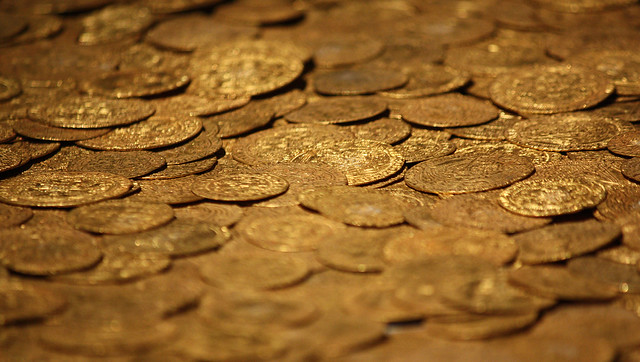
The records of the medieval and early modern periods are littered with references to money, whether referring to the value of lands, payments to staff or the costs of constructing and maintaining castles. This article describes what English medieval coins were like, how money functioned in the economy, and how much castles and other items cost.
What was the money like?
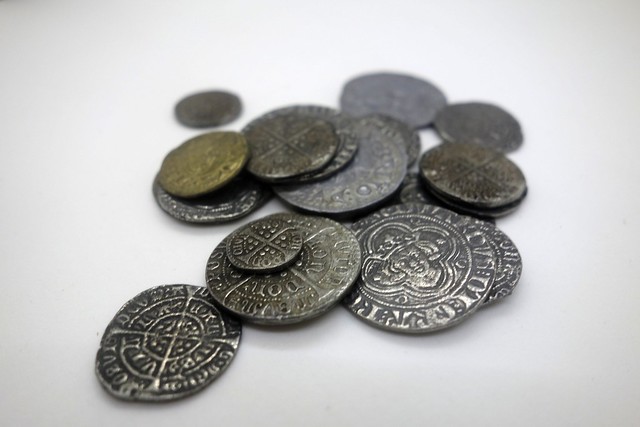
English money in the medieval period took several forms. Firstly, there were coins, the most widespread of which was the silver penny, first introduced by Offa, the King of Mercia, in the 8th century. The penny formed the main currency throughout the period.
Silver pennies were thin coins, about 1.5 cm (0.59 in) across – 240 pennies weighed the same as 349 grams (12.3 oz) of silver, also known as a “tower pound”. Since they were too valuable for many day-to-day purchases, pennies were sometimes cut into halves or quarters to create smaller change, until halfpennies and farthings began to be introduced in 1279 as alternatives. The groat, a larger silver coin worth 4 pence, was introduced in 1279, followed by the half-groat, worth 2 pence.
Gold coins were first introduced in 1257, when a gold penny, designed for alms-giving, was issued by the English mints. Gold coins only became used more generally after 1344, when the leopard coin was issued. The leopard was officially valued the same as 72 silver pence, and also had half and quarter equivalents. The noble followed, worth 80 pence, again with half and quarter versions. In 1465, the rose noble was created, worth 120 pence, and the angel, worth 80 pence. Gold coins were always much more valuable than the silver coins used in normal life.
But not all money existed in the form of coins. Financial records, such as deposit, debts or contracts, were usually written down in terms of silver pennies, but larger sums were recorded in shillings (one shilling equating to 12 pence) and pounds (240 pence). Financial sums could also be recorded in marks (160 pence) and ora (originally 16 pence, later 20 pence). Shillings, pounds, marks and ora had no physical coinage associated with them: they were simply “units of account”.
| Title | Description | Value |
|---|---|---|
| Penny | Silver coin | 1 pence |
| Half-penny | Silver coin | ½ pence |
| Farthing | Silver coin | ¼ pence |
| Groat | Silver coin | 4 pence |
| Half-groat | Silver coin | 2 pence |
| Leopard | Gold coin | 72 pence |
| Noble | Gold coin | 80 pence |
| Rose noble | Gold coin | 120 pence |
| Angel | Gold coin | 80 pence |
| Shilling | Unit of account | 12 pence |
| Pound | Unit of account | 240 pence |
| Mark | Unit of account | 160 pence |
| Ora | Unit of account | 16 pence, later 20 pence |
How was the money made?
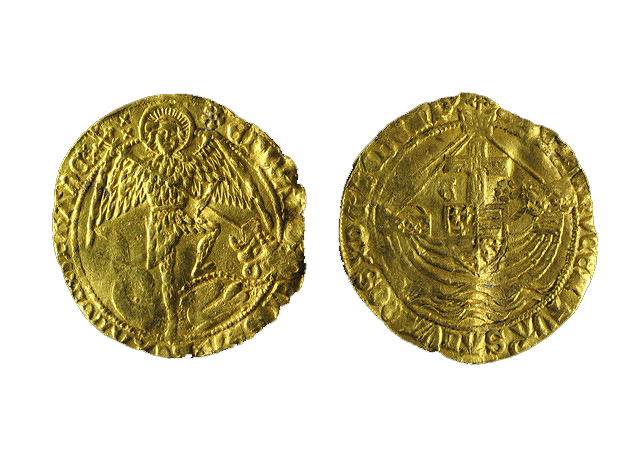
Medieval coins were minted by hand, by placing a square piece of blank metal between the two halves of a die, called a pile and trussel. These were then struck with a hammer to imprint the design, after which the coin was trimmed by hand to make it circular.
After the Norman conquest, this process was controlled centrally by the Crown, which determined the designs, weight and metal content of the coins. Detailed instructions and orders were sent out to the regional mints, where local moneyers would carry out the work. There were around 70 local mints in the 11th century, but the work was increasingly centralised and by the 14th century there were only a handful left.
From time to time the Crown would recall, melt down and reissue all the English coinage, but there in between there remained a need to regularly recycle existing coins. Silver coins were relatively soft and wore away with regular use, so their owners would routinely take them into a local mint to be restruck. The scale of this work was impressive; there were huge numbers of coins in circulation, all of which had to manufactured and regularly remade by hand by the mints.
When making the coins, moneyers would add a small quantity of non-precious metals to the silver to produce a harder alloy, which was essential if the coins were to be sufficiently durable to be used in trade. This process also allowed moneyers to create at least two and a half percent more coins than would otherwise have been the case, which they were then allowed to keep as, effectively, their profits for carrying out the minting. The Crown made its own profits out of the process, by charging the moneyers or their local communities a fixed fee for the right to carry out the work. This system was slowly dismantled over the medieval period, however, as the number of mints was reduced.
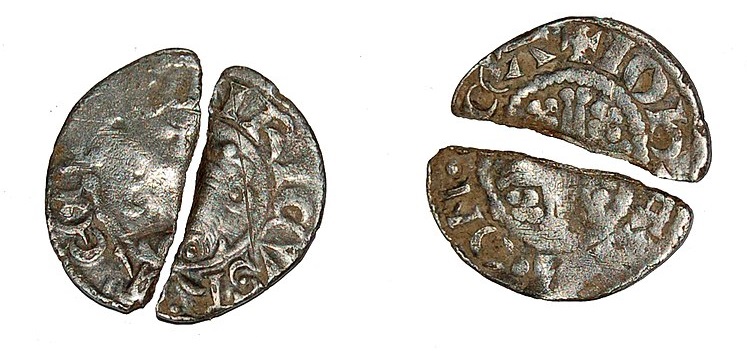
There was often a tension between the value of a medieval coin as a unit of currency, and its value as a precious metal. If the silver or gold in a coin was worth more than the coin would buy in a market, for example, the owners would be tempted to melt them down and sell the raw precious metal. This was particularly important when both gold and silver coins were in circulation later in the period, as the differences in the value of gold and silver could easily be exploited.
As an example, in theory the value of a gold leopard was fixed at 72 silver pennies. But, if the market value of raw gold increased by relative to silver, by, say, around 10 percent, then it would beneficial to melt down any gold leopards and sell that raw gold on. Someone doing this would be realizing a profit of 8 pence on each of the gold coins they destroyed. This process quickly tended to drive gold coins out of circulation as they were melted down by their owners. If the value of gold fell relative to silver, one could profit by carrying out the process in reverse.
Clipping, where traders would trim small amounts off the edge of coins before passing them on as underweight currency, was also a problem. Edward I’s long cross penny, issued in 1279, was in part an attempt to combat this – its design reached out to the edge of the coin, making any clipping easier to detect.
The usury laws in England forbade Christians from lending money at interest, a role which instead became associated with the Jewish community. The first Jews arrived in England in the aftermath of the Norman invasion, and expanded out across the country, providing essential money-lending and banking services. Towards the end of Henry II’s reign, however, the Crown ceased to borrow from the Jewish community and instead turned to extracting money from them through arbitrary taxation and fines. The Jewish community became increasingly impoverished and abused, until it was finally expelled from England in 1290 by Edward I, being replaced by foreign merchants.
How much money was there? How was it used?
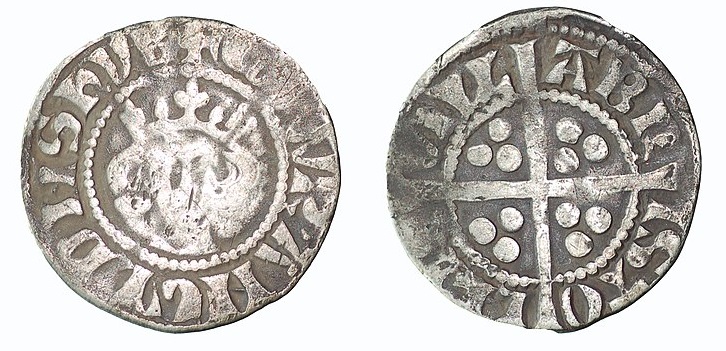
Historians are uncertain exactly how many coins were in circulation in medieval England and Wales. Their estimates depend on a combination of surviving records and physical evidence from the royal mints, and the size and content of the various coin hoards discovered from the period.
After the Norman invasion, there may have been anywhere between £10,000 and £25,000 in circulation in England, or perhaps as many as 9 million silver pennies. The currency in circulation expanded hugely during the late-12th century, and may have reached may have reached £250,000 by 1205. Estimates suggest that between £1,500,000 and £2,000,000 was in circulation by 1313, or up to 290 million coins. Taking into account the growing population over the period, this meant that while in 1066 there was only one or two silver pennies for each person in the country, by 1331 there at least eighty coins in circulation per person.
Alongside the quantity of coins, however, we also need to consider what economists call the “velocity of circulation”, or the speed with which coins passed around the medieval economy. Imagine if a peasant farmer who acquired a silver penny at market typically waited a year before spending it again; the physical money in the economy would be moving relatively slowly around the system. Contrast that with a situation in which that farmer, on average, used the coin immediately again the next day to buy something: exactly the same amount of coinage, spent more quickly, could fuel a much more dynamic economic system.
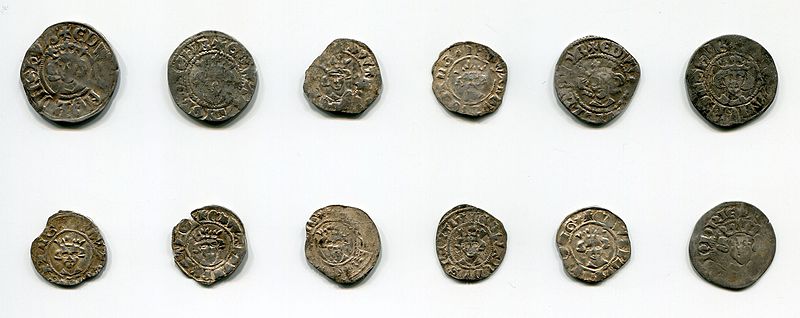
Royal taxation made a major difference to the velocity of circulation. When the Crown imposed a tax, coins were collected in from across the kingdom as payment and stored in barrels until they were needed. Other major barons also stored large quantities of money, in case of contingencies. This could severely restrict the availability of money, with an impact on the medieval economy. During some periods of the medieval era, more bullion was leaving England and Wales than was returning in trade, producing periods of shortage.
Many debts, even if they were recorded as a monetary sum, might often be paid off, in part or in total, with other goods – particularly when physical coins were in limited supply. Meals, animals, wool and other items were used to settle debts – although arguments over their actual value often ended up in court.
How much money did you need to be rich?
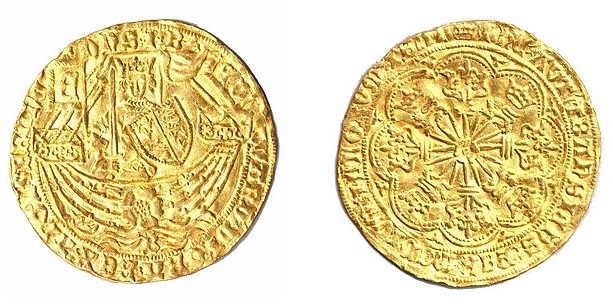
Shortly after the Norman conquest, around 170 baronies had been established across England; the average baron had an income of a little over £200 a year, with the wealthiest bringing in over £750, and the poorest less than £100. By 1200, the top 160 barons were still enjoying incomes of around £200 a year, with the wealthiest handful possessing lands worth as much as £750 a year.
Over the next century, however, the wealthiest nobles saw their incomes grow considerably, as they created huge estates – Richard of Cornwall possessed lands bringing him almost £4,000 a year, for example. These huge levels of income could not be sustained, but inflation steadily increased the incomes of all the barons over the next century, until by 1436 over half of them enjoyed incomes of over £500 a year.
We also know how much the constables of the royal castles were paid by the Crown. In 1287, for example, the fees paid to the protectors of the largest castles like the Tower of London or Chester for their work were £50 and £40 respectively; a much smaller property like Cambridge Castle was only worth a fee of £5.
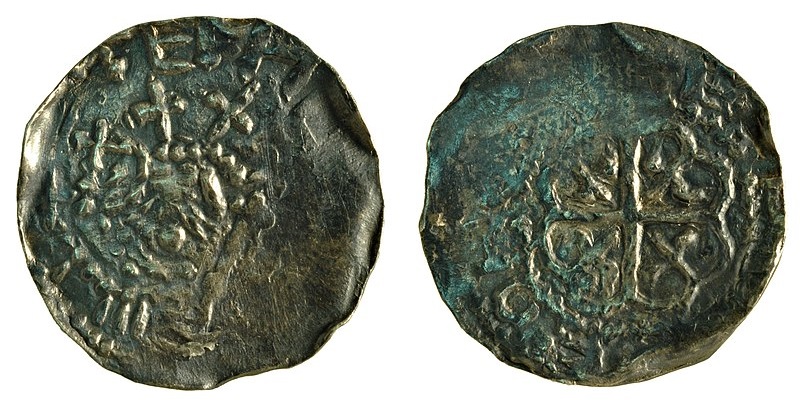
Although the very earliest records of payments to castle garrisons have typically been lost, more documents have survived from the 13th century onwards. A porter would have been paid 4 pence a day, and a watchman, 2 pence. Military personnel received considerably more: a knight cost 2 shillings a day to employ, a sergeant, 7 and a half pence, and a crossbowman, 3 and a half pence. A noble wishing to endow his castle chapel with an income to support the chaplain and their staff might have needed to provide land worth anywhere between £2 and £25, depending on the location, size of the establishment and the degree of comfort they expected the clergy to enjoy.
At the other end of the social spectrum, many of the rural poor would not have earned a wage in the modern sense of the word, instead relying on farming their land, selling some of their produce, and in some cases providing non-free services to their manorial lord, working on their lands, providing goods or other services. By the 14th century, perhaps only a third of the population earned a wage in the way we would recognise it today.
We have some records of this employment. Before the Black Death, an unskilled labourer would have earned one and half pence a day; after the epidemic and the consequent reduction in the workforce, this rose to around 3 pence by the 1390s. Craftsmen saw a similar increase over this time, from 3 pence a day to 5 pence.
How much did it cost to build a castle?
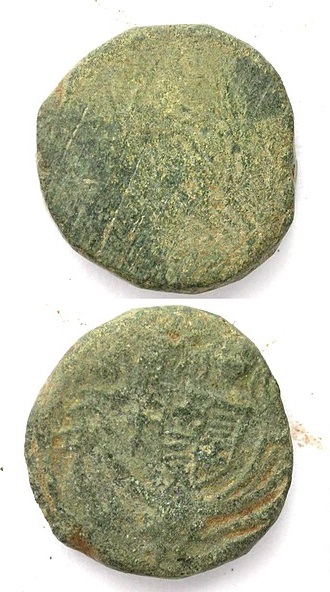
Historians do not have many records to show how much it cost – either in terms of money or resources – to build the early castles. Probably only the wealthiest top-third of the barons could have afforded to construct castles, along with some of the major landowning knights under the great barons – and, of course, the King himself.
The earliest castles in England, made from earth and timber, required relatively little skilled labour to build. The huge amounts of earth-moving that was required – up to 24,000 days of effort for the more substantial castles – could have used forced effort from the local population.
Later stone castles were a different matter, and required barons to employ skilled craftsmen. In the late 12th century, a simple stone castle would cost at least around £400 to build – around twice the yearly income of a typical baron. Around this time, the Crown was spending very large amounts on a handful of key castles. Henry II spent £1,413 on constructing Orford Castle between 1165 and 1173, for example, while £8,248 and £4,019 was spent by Henry and his heirs on developing Dover Castle and the Tower of London.

A century later, and King Edward I’s construction work in the newly conquered North Wales proved particularly expensive. Between 1282 and 1304, the total cost of his castle building came to at least £80,000, almost six times Edward’s annual income. Caernarfon’s and Conwy’s castles and town walls, for example, each came to around £15,500 to construct, while Harlech Castle cost £8,190 to erect. Such works would have been well beyond the income of any but the wealthiest baron.
Castles also cost money to maintain in good condition: stonework needed to be repaired, lead roofs renewed, and timbers replaced. Smaller castles, with the support of a surrounding estate, might be maintained for a few pounds a year, but larger fortifications required much more. The constable of Conwy Castle had been initially provided with £190 a year for such works, for example. This was a reasonable sum but as the funding soon fell away to £40 a year, so did the condition of the castle, which began to crumble.
How much would medieval money be worth today?
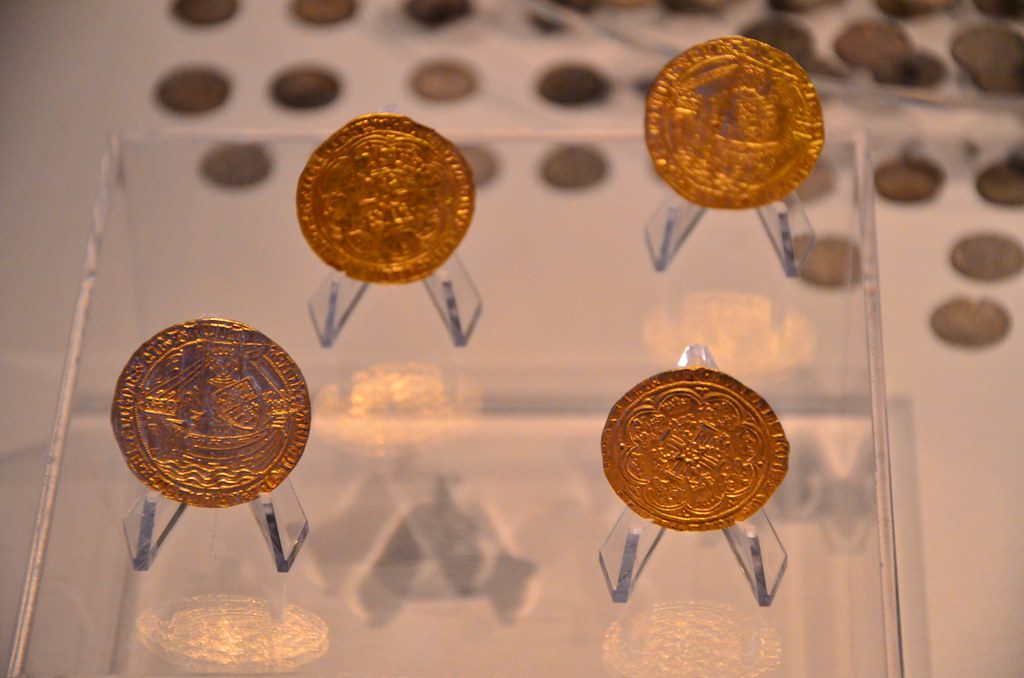
So, how much would medieval money have been worth in modern terms? This sounds simple, but is actually a very challenging question.
The heart of the problem is that we can’t really move money between historical periods; we don’t have time machines! As a result, we’re trying to get at the sense of what money was “worth” in a particular period, and what might “feel like” to us today. Was a castle costing £200 in 1270 expensive or cheap? Was someone earning £2 a year in 1400 wealthy or poor?
One method used in the modern period is to make a comparison using an index that allows us to inflate older sums of money to reflect their comparatively greater value today. Typically, the further back in the medieval period we go, the more we need to inflate the value of money to make it equivalent to our own period. There are different methods of doing this, three of which are described below, each trying to answer the question “what would £1 in 1270 be worth today?”
Price Index
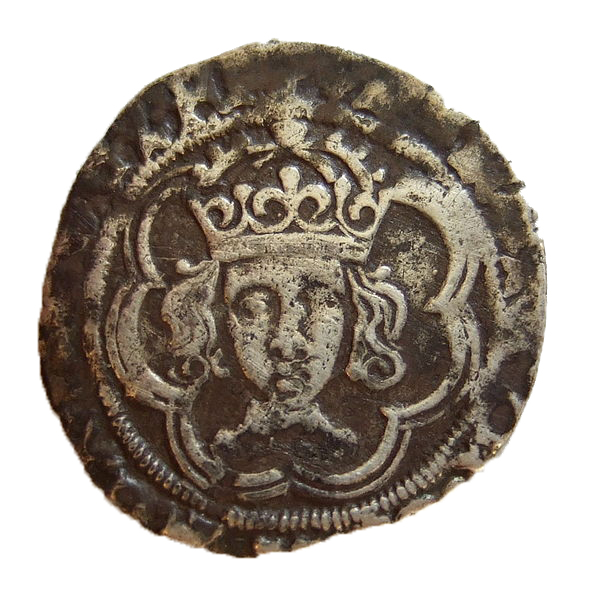
One method is to make a comparison using the price of common goods, trying to work out how prices have risen over the years. The Consumer Price Index (CPI) and the Retail Price Index (RPI), for example, create bundles or “baskets” of goods and service bought by households in particular years, and weighted according to their importance in household budgets of the period. A change in the index shows a change in the value of money over time. An RPI price index comparison would suggest that £1 in 1270 would be worth £940 today in 2018.
There are problems with such an approach. We know that many medieval workers would have provided their labour as part of a feudal relationship, and were often compensated in kind. Barter would have been much more common than today, and tracking market prices therefore tells us only a small part of the economic picture. Money was used much more extensively by the rich in medieval society, distorting any price index comparison.
In addition, centuries of economic growth mean that the “baskets” of goods in 1270 and 2018 are not truly comparable: we would be comparing medieval bread with take-away pizzas, internet games and automobiles. Almost all of us are vastly richer today than our medieval forebears.
Average Wages
An alternative is to use an Average Wage Index. Rather than comparing prices over time, these indexes compare how much of an average person’s income is needed to purchase something. Wage indexes can help us to take into account the growth of the economy over time. Using a wage index, £1 in 1270 would be worth around £16,290 in 2018 terms.
Even this isn’t perfect though. Many of the considerations above about the medieval economy apply to average wages too: many medieval workers would never have received regular financial payment for their labour. Relatively small amounts of money are also worth somewhat less to the extremely wealthy, but a great deal to the disadvantaged. This certainly applies during the medieval period, when the difference in wealth was often extreme.
Economic Share
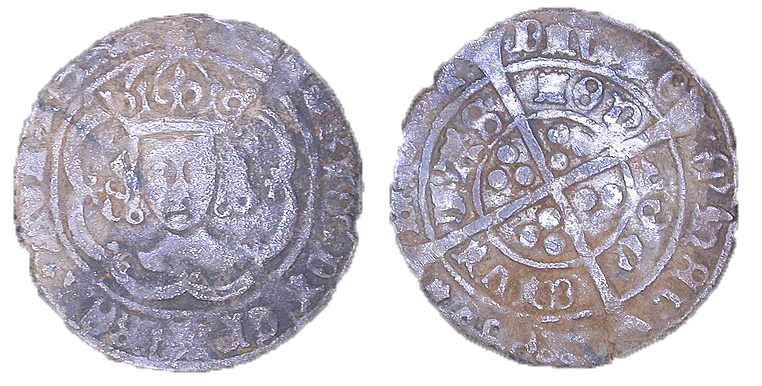
A third approach is to take a share of Gross Domestic Product (GDP) approach. This involves working out what percentage of the overall UK economy a particular sum reflected at the time, and then working out what an equivalent percentage would be today. Using a GDP per capita measure, £1 in 1270 would be worth around £33,540.
Needless to say, however, determining the GDP of medieval England is not straightforward. You will have seen the wide difference in opinion even about how many coins there were in circulation, let alone any attempt to estimate the volume of feudal services rendered. Any estimate of a medieval GDP is likely to be uncertain at best.
Conclusions
Unsurprisingly, then, there are no simple ways to compare medieval and modern financial figures. That sum of £1 in 1270 in the reign of Edward I might equate to anywhere between £940 and £33, 540 in 2018 terms – a very wide difference.
If we want to really understand what a castle cost, or whether a particular baron was wealthy or poor, it is usually best to seek answers by looking comparatively at other medieval events, rather than relying on historical financial statistics: How much did other fortifications cost to build? What did their peers enjoy in terms of income? Did their contemporaries think their projects were expensive or modest? One thing you can be sure of, though: the medieval poor would have been very poor indeed by modern standards, and their lives very hard indeed.
Bibliography
- Bolton, J. L. (2012). Money in the Medieval English Economy: 973-1489. University of Manchester Press: Manchester, UK.
- Dyer, Christopher. (2000). Everyday Life in Medieval England. Hambledon: London, UK.
- Dyer, Christopher. (2009). Making a Living in the Middle Ages: The People of Britain, 850-1520. Yale University Press: New Haven, US and London, UK.
- MacFarlane, Helen and Paul Mortimer-Lee. (1994) Inflation over 300 Years. Bank of England: London, UK
- Pounds, N. J. G. (1990). The Medieval Castle in England and Wales: A Social and Political History. Cambridge University Press: Cambridge, UK.
The Measuring Worth website was also used as a key source.
Attribution
The text of this page is licensed under under CC BY-NC 2.0.
Photographs on this page are drawn from the Wikimedia and Flickr websites, as of 18 April 2019, and attributed and licensed as follows: “Medieval money“, author ash crow, released under CC BY-SA 2.0; “Fishpool gold coins“, author Lawrence OP, released under CC BY-SA 2.0; “3007 Silver penny of John (FindID 278253)“, author The Portable Antiquities Scheme/ The Trustees of the British Museum, released under CC BY-SA 2.0; “Medieval coin“, author Portable Antiquities Scheme, released under CC BY 2.0; “2101 Silver penny of Edward I (FindID 218128)“, author The Portable Antiquities Scheme/ The Trustees of the British Museum, released under CC BY-SA 2.0; “2012T303 obverse (FindID 499191)“, author The Portable Antiquities Scheme/ The Trustees of the British Museum, released under CC BY-SA 2.0; “Medieval coins from a hoard found at Epping“, author Ben Sutherland, released under CC BY 2.0; adapted from “Medieval coin, Rose noble of Edward IV (FindID 890209)“, author Oxfordshire County Council, released under CC BY-SA 2.0; adapted from “Medieval coin weight (rose noble) (FindID 385637)“, author The Portable Antiquities Scheme/ The Trustees of the British Museum, released under CC BY-SA 2.0; adapted from “Medieval silver coin of Stephen (FindID 496877)“, author The Portable Antiquities Scheme, released under CC BY-SA 2.0; adapted from”English half-groat (1488-89)“, author Jerry “Woody”, released under CC BY-SA 2.0; adapted from “Medieval silver groat (FindID 398725)“, author The Portable Antiquities Scheme/ The Trustees of the British Museum, released under CC BY-SA 2.0.
